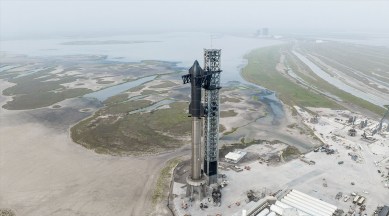SpaceX to attempt Starship launch again on Thursday
SpaceX said that it would attempt the first launch of its Starship rocket system on Thursday, April 20, after a launch attempt on Monday had to be scrubbed due to issues with the launch vehicle's first stage.

After scrubbing the first launch attempt, SpaceX plans to launch its Starship rocket system from the Starbase launch facility in Texas on Thursday, April 20. According to the Elon Musk-led company, the launch window on the date opens at 6.58 PM IST and closes at 8 PM.
Starship’s first orbital test launch attempt on Monday had to be postponed nine minutes before the planned launch time because of issues with pressurisation on the Super Heavy first stage. SpaceX streamed the launch attempt live on its YouTube channel.
monthly limit of free stories.
with an Express account.
Once it is fully developed, Starship could be the most powerful launch vehicle ever created in history. It will have twice the thrust of the Saturn V rockets used during the Apollo moon missions and a payload capacity of 150 tons.
While Thursday’s launch would be the first launch test of the full Starship system, SpaceX has already completed many sub-orbital flight tests of the Starship upper stage. Apart from tests of the Starship spacecraft, the company has also conducted many static fire tests of the Super Heavy lower stage, which is powered by 33 Raptor engines. Click here to learn more about the entire Starship system.
Both the Starship spacecraft (upper stage) and the Super Heavy rocket (lower stage) are designed to be reusable. Super Heavy is designed to land back at the launch site after it propels Starship into orbit, but SpaceX will not attempt to do that on Thursday. Instead, Super Heavy will splash down in the Gulf of Mexico.
Meanwhile, the Starship spacecraft will orbit the Earth partially before splashing down in the Pacific Ocean less than two hours later.
Of course, since this is the first test of what could be the most powerful rocket system ever designed, not everything will necessarily go according to plan.
“With a test such as this, success is measured by how much we can learn, which will inform and improve the probability of success in the future as SpaceX rapidly advances development of Starship,” wrote SpaceX in the mission description.
After Starship goes through a series of rigorous tests like the one planned for Thursday, it will be part of an uncrewed mission where it will land on the Moon. NASA says that it will begin using the rocket system for the Artemis Moon missions after its fully developed.
Elon Musk and SpaceX have even bigger ambitions for the Starship system and hope it can also be used on future crewed missions to the Moon.